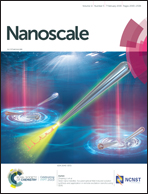Differentiation of selectively labeled peptides using solid-state nanopores†
Abstract
Determination of the amino acid sequence of a protein is critical for understanding various biological processes. Mass spectrometry has mainly been used for protein identification; however, there are limitations to its sensitivity when detecting low abundance proteins. In this study, we attempted to distinguish between three similar peptide sequences (∼40 amino acids, ∼5 kDa) that differed only by the location or number of cysteine residues with solid-state nanopores. The cysteine residues are located at one end, one at the center, and at both ends for each of the three peptides. We found that differentiation of the three types of peptides by nanopore signals was difficult. However, when the cysteine residue was labeled with a negatively charged molecule, Flamma® 496, the labeled peptides showed distinct signals for each peptide. Comparing the relative current blockades of labeled peptides with applied voltages, we found that the label was able to change peptide conformations and the resulting ionic current signals from the three labeled peptides were distinguished based on the relative current blockade, full width at half-maximum of the current blockade distribution, and single-molecule level peak shape analysis. Our results suggest that solid-state nanopores combined with a targeted labeling strategy could be used to obtain characteristic peptide signatures that could ultimately be used for protein identification.



 Please wait while we load your content...
Please wait while we load your content...